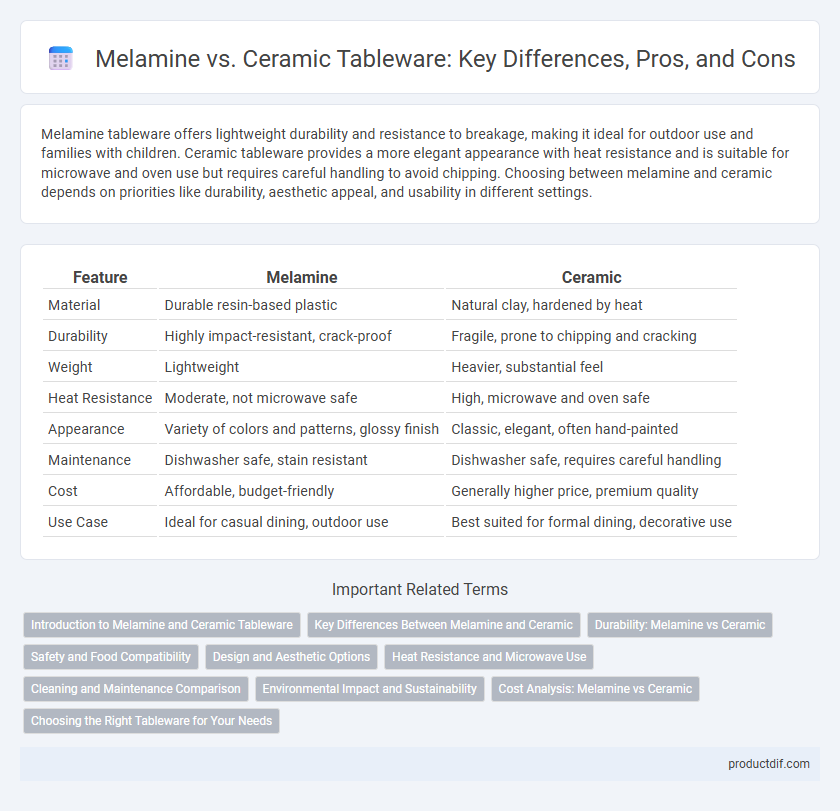Melamine tableware offers lightweight durability and resistance to breakage, making it ideal for outdoor use and families with children. Ceramic tableware provides a more elegant appearance with heat resistance and is suitable for microwave and oven use but requires careful handling to avoid chipping. Choosing between melamine and ceramic depends on priorities like durability, aesthetic appeal, and usability in different settings.
Table of Comparison
| Feature | Melamine | Ceramic |
|---|---|---|
| Material | Durable resin-based plastic | Natural clay, hardened by heat |
| Durability | Highly impact-resistant, crack-proof | Fragile, prone to chipping and cracking |
| Weight | Lightweight | Heavier, substantial feel |
| Heat Resistance | Moderate, not microwave safe | High, microwave and oven safe |
| Appearance | Variety of colors and patterns, glossy finish | Classic, elegant, often hand-painted |
| Maintenance | Dishwasher safe, stain resistant | Dishwasher safe, requires careful handling |
| Cost | Affordable, budget-friendly | Generally higher price, premium quality |
| Use Case | Ideal for casual dining, outdoor use | Best suited for formal dining, decorative use |
Introduction to Melamine and Ceramic Tableware
Melamine tableware is a durable, lightweight material made from a thermosetting plastic resin, offering high resistance to breakage and ideal for outdoor or everyday use. Ceramic tableware, crafted from natural clay and fired at high temperatures, provides a classic aesthetic with excellent heat retention and is often favored for formal dining settings. Both materials serve distinct functional and stylistic roles, with melamine excelling in practicality and ceramic valued for elegance and tradition.
Key Differences Between Melamine and Ceramic
Melamine tableware is lightweight, durable, and resistant to breakage, making it ideal for outdoor use and casual dining, while ceramic offers a heavier, more elegant option with superior heat retention and a non-porous surface that resists stains. Melamine is generally more affordable and dishwasher-safe but not microwave-safe, whereas ceramic can usually withstand both dishwasher and microwave use. The distinct manufacturing processes result in melamine being made from a type of plastic resin, whereas ceramic is crafted from natural clay materials fired at high temperatures for a solid, glass-like finish.
Durability: Melamine vs Ceramic
Melamine tableware offers superior durability compared to ceramic, as it resists chipping, cracking, and breaking even when dropped or subjected to heavy use. Ceramic is more prone to damage from impacts and thermal shock, making it less ideal for environments that require robust, long-lasting dishware. Melamine's lightweight yet resilient properties make it a preferred choice for both commercial and casual dining settings where durability is essential.
Safety and Food Compatibility
Melamine tableware is highly durable and resistant to breakage, making it a safe choice for outdoor use, but it is not microwave-safe and can leach harmful chemicals when heated. Ceramic tableware is food-safe, microwave, and dishwasher-friendly, offering non-toxic glazing that prevents chemical leaching, ensuring safe food compatibility. For health-conscious consumers, ceramic provides a safer option for hot foods, while melamine suits cold or room temperature meals.
Design and Aesthetic Options
Melamine tableware offers vibrant colors and modern patterns with a lightweight, durable design ideal for casual dining and outdoor use. Ceramic tableware provides a classic, elegant aesthetic featuring intricate glaze finishes and varied textures suited for formal settings. The choice between melamine and ceramic centers on the balance between contemporary versatility and timeless sophistication in design.
Heat Resistance and Microwave Use
Melamine tableware offers excellent heat resistance up to 160degC but is not microwave safe due to the risk of warping and chemical leaching. Ceramic tableware withstands higher temperatures, typically over 300degC, and is generally safe for microwave use, making it ideal for reheating food. Heat retention in ceramic is superior, providing durability and consistent performance under thermal stress compared to melamine.
Cleaning and Maintenance Comparison
Melamine tableware offers easy cleaning with its non-porous surface that resists stains and odors, making it dishwasher-safe and ideal for busy households. Ceramic tableware, while more prone to chipping and staining, requires gentle hand washing to preserve its glaze and intricate designs. Regular maintenance for ceramic includes avoiding abrasive scrubbers to maintain its finish, whereas melamine's durability allows for more flexible cleaning methods without damage.
Environmental Impact and Sustainability
Melamine tableware, made from a type of durable plastic resin, is non-biodegradable and contributes to long-term landfill waste, raising sustainability concerns. Ceramic tableware, composed of natural clay and minerals, is more environmentally friendly due to its biodegradability and potential for recycling or repurposing. Ceramic production involves higher initial energy use but results in a more sustainable lifecycle compared to melamine's synthetic chemical composition and limited recyclability.
Cost Analysis: Melamine vs Ceramic
Melamine tableware typically costs 30-50% less than ceramic, making it a budget-friendly option for large-scale or casual dining settings. Ceramic tableware, while more expensive, offers superior durability and heat resistance, often justifying higher prices in fine dining or long-term use scenarios. The choice between melamine and ceramic hinges on balancing initial cost savings against factors like longevity and aesthetic appeal.
Choosing the Right Tableware for Your Needs
Melamine tableware offers superior durability and shatter resistance, making it ideal for outdoor use and families with children, while ceramic provides a more elegant aesthetic and is microwave safe, perfect for formal dining and everyday home use. Ceramic dishes typically retain heat longer and are more scratch-resistant, whereas melamine is lightweight and less prone to chipping. Selecting between melamine and ceramic depends on lifestyle factors such as usage frequency, setting, and care preferences, ensuring the tableware aligns with practical needs and desired appearance.
Melamine vs Ceramic Infographic

 productdif.com
productdif.com